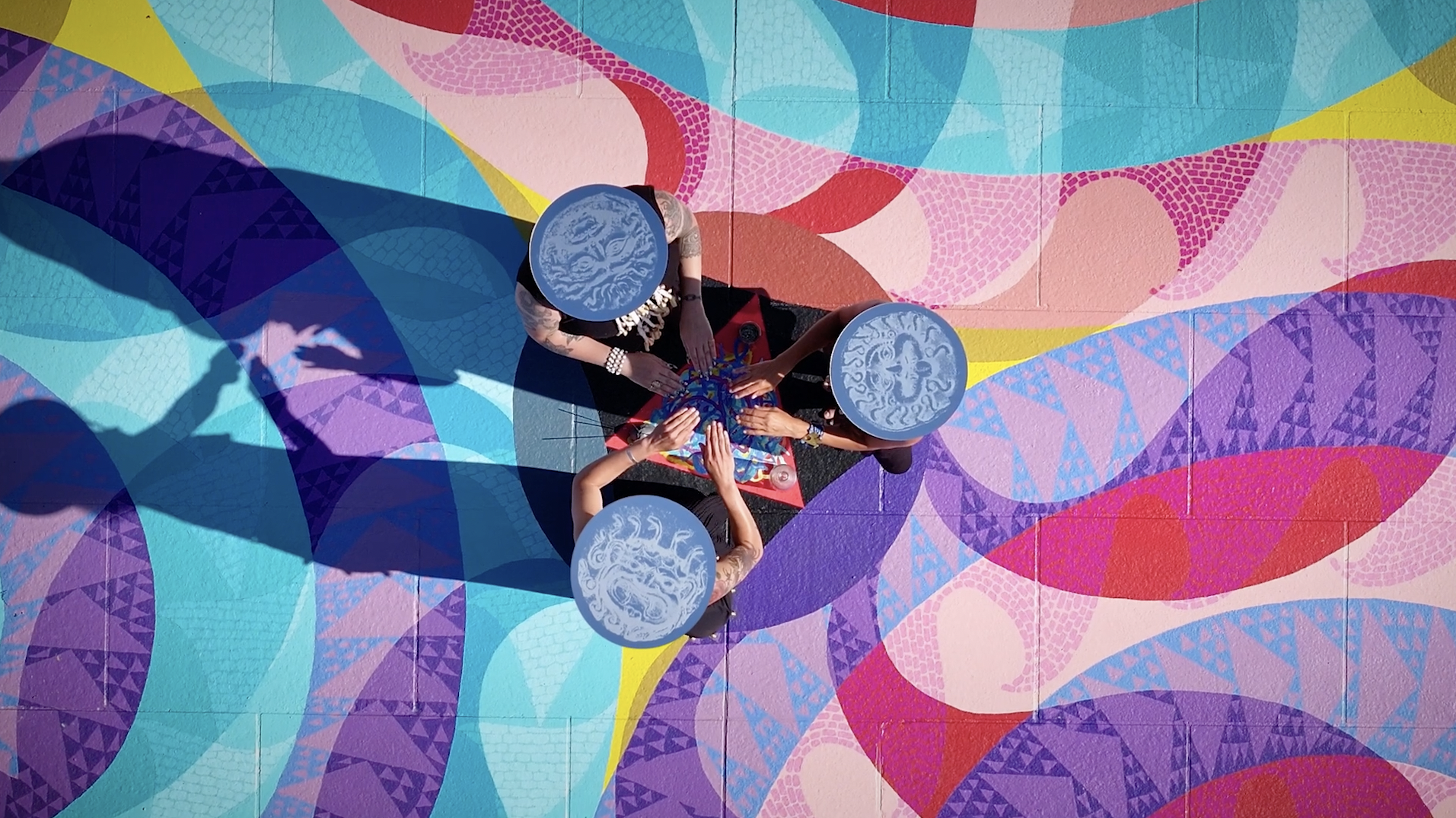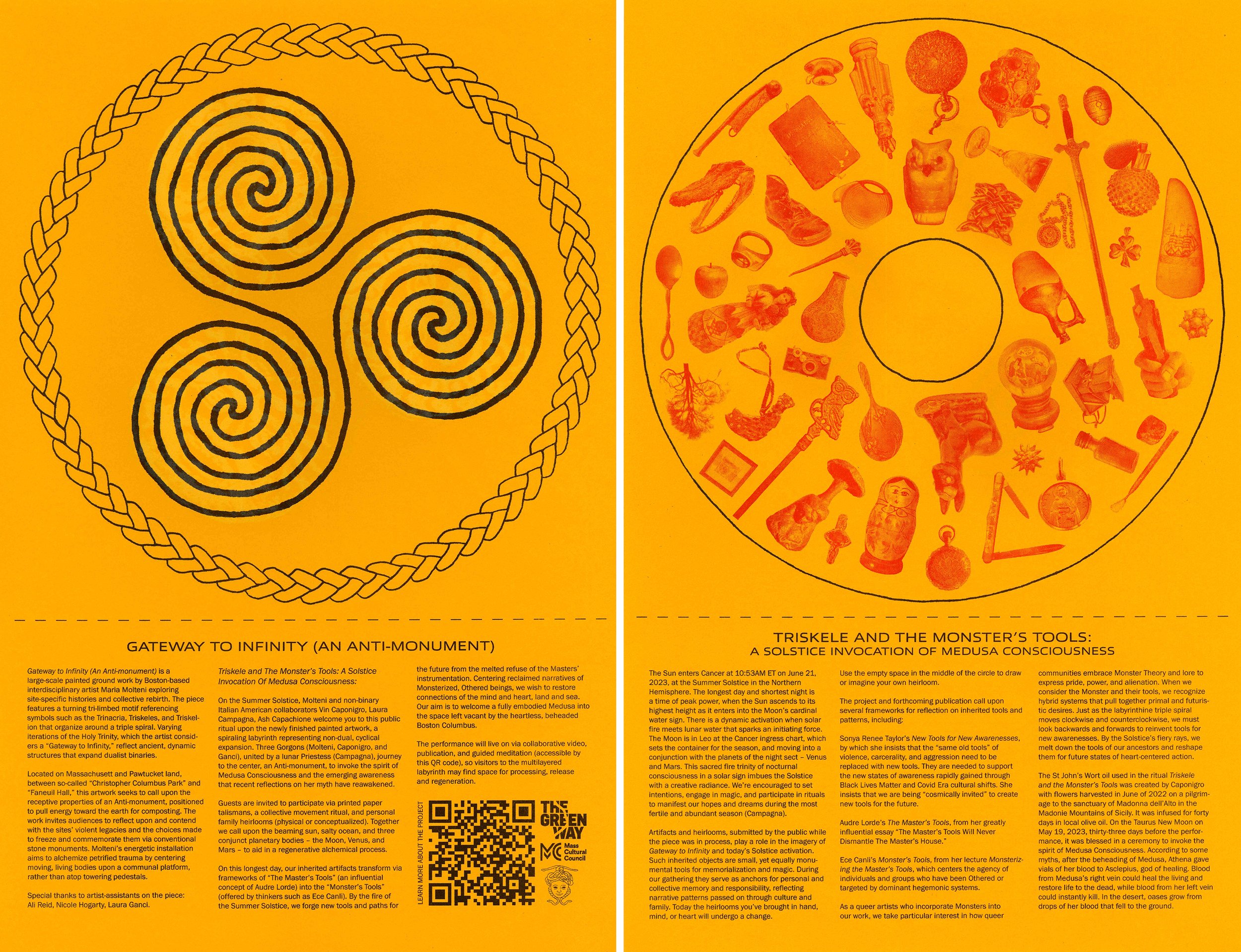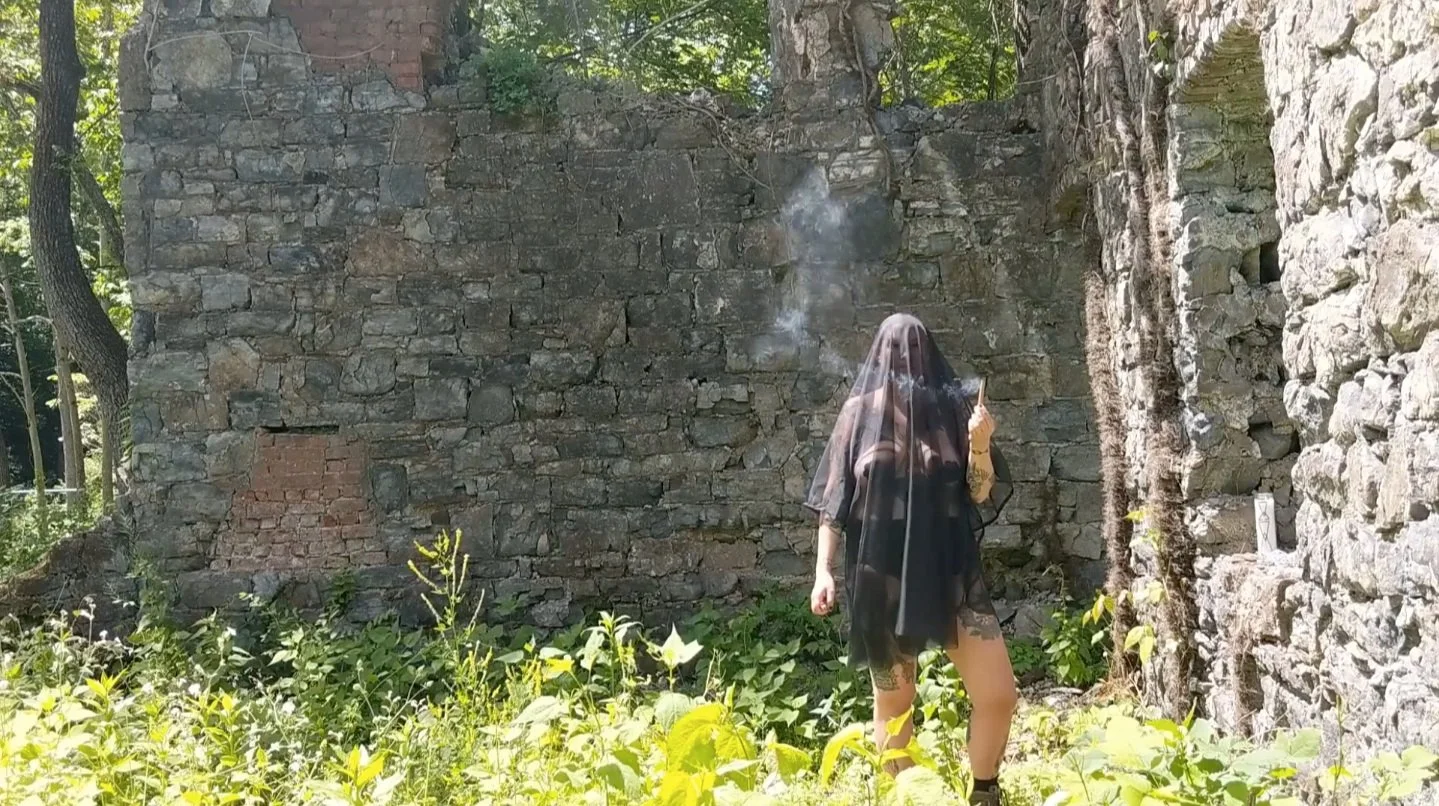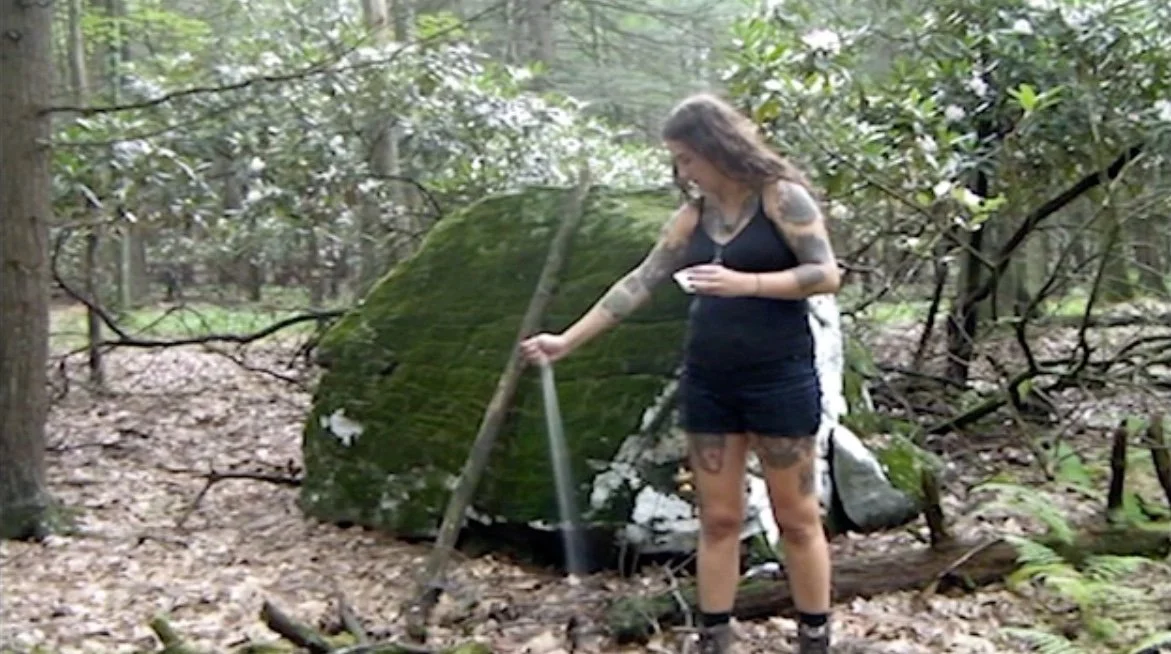Triskele & The Monster’s Tools: A Solstice Invocation of Medusa Consciousness
Boston, MA
2023
A public ritual on Maria Molteni’s painted artwork Gateway to Infinity (An Anti-Monument), a spiraling labyrinth representing non-dual, cyclical expansion. Collaboratively conceived by non-binary Italian American collaborators Vin Caponigro, Laura Campagna, Ash Capachione. Three Gorgons (Molteni, Caponigro, and Laura Ganci), united by a lunar Priestess (Campagna), journey to the center, an Anti-monument, to invoke the spirit of Medusa Consciousness and the emerging awareness that recent reflections on her myth have reawakened.
Guests were invited to participate via printed paper talismans, a collective movement ritual, and personal family heirlooms (physical or conceptualized). Together we called upon the beaming sun, salty ocean, and three conjunction planetary bodies – the Moon, Venus, and Mars – to aid in a regenerative alchemical process. On this longest day, our inherited artifacts transformed via frameworks of “The Master’s Tools” (an influential concept of Audre Lorde) into the “Monster’s Tools” (offered by thinkers such as Ece Canli). By the fire of the Summer Solstice, we forged new tools and paths for the future from the melted refuse of the Masters’ instrumentation. Centering reclaimed narratives of Monsterized, Othered beings, we wish to restore connections of the mind and heart, land and sea. Our aim is to welcome a fully embodied Medusa into the space left vacant by the heartless, beheaded Boston Columbus.
The paper talisman takeaways contain information about the project and images submitted heirlooms. They were riso printed in purple and scarlet and screen printed with glow in the dark ink that reveals three gorgons over the triskelion when they are charged in light. Download a PDF of the takeaway here.
Medusa: Myth, Memory, (Anti) Monument
Transforming Histories. Beheading Binaries. Waking the Monster’s Tools.
The publication includes writings that contextualize the collaborative ritual in mythological, historical, political, and poetic terms, with an introduction by art historian Liz Andres, and essays by artist Maria Molteni, astrologer Laura Campagna, and artist Vin Caponigro.
Zine are available to purchase here, and are also provided on site at no cost by the Rose Fitzgerald Kennedy Greenway Conservancy. A pdf is available here.
The Malleus Maleficarum was first printed in 1487. A subsequent edition was printed in Latin by Anton Koberger in Nuremberg on March 17, 1494, and made available digitally by the National Library of Medicine.
Each page of the 1494 edition was laser duplex printed, then shredded. The pieces were then burned to ash and mixed with transparent base and water. A dildo was then dipped into the ash mixture, and dropped fifty times, once each for when the author mentions member as a euphemism for penis in the text.
The text in this publication comes from the translation by Montague Summers, first published in 1928 and available as a pdf through Global Grey EBooks.
In addition to the documented 36 editions which were printed between 1486 and 1669, there were at least 51 editions printed in Latin, German, Spanish, Italian, Greek, Polish, and English between 1850 - 2024. The publication is riso printed in an edition of 87, one for each edition.
To document the performance, nine small riso prints were created in flat gold and black. Each contains an enlarged detail from the print created during the performance on the front, and together they can be pieced together to create the full print on the back.
Sono Il Mio Santo
Tusa, Sicily
2019
Performed several kilometers from Caponigro’s ancestral village of Pettineo, Sono Il Mio Santo (I am My Own Saint) is a ritualistic pilgrimage that begins at a large stone building at the top of the town and winds through the streets to a rock formation at the edge of the countryside. Wearing a cyanotype garment made with native plants that references the specific type curtain found on many balconies in the village, Caponigro blesses the area with salt water brought up from the sea and ginestra before drawing a protective sigil in chalk and gifting the formation with two potted plants, purchased from a small shop in town. The ritual ends back at the sea, with Caponigro throwing leaves of ginestra into the waves.
Flying Ointment
Rosendale, NY
2019
Watering
Rosendale, NY
2019
Responding to the industrial history of the Hudson Valley and it’s unexpected relationship to their family home – 130 miles south but connected by a maze of canals and abandoned railroads – Flying Ointment + Watering are a duo of related videos one set in a large mugwort field directly behind their temporary residence and the other amongst so-called weeds in the ruins of a building once used by the natural cement industry. Both document the rituals Caponigro performed on site, incorporating protective elements, the healing properties of the native and invasive plants growing in the area, and its history of destructive extraction. Shrouded, Caponigro performs a series of different but related actions, creating a flying ointment and rubbing it on a handmade broom, baptizing themself with a bowl of water and tiny stones collected nearby, watering garlic mustard, fleabane, and plantain, and drawing sigils on their palms and stone structures.
Mugwort
Watercolor mono print with embossing powder
made with direct contact of stalks of mugwort used in the performance
22 in x 30 in
2019
Mark of the Devil
Steuben, WI
2018
During the witch trials, the accused were often stripped and all of their body hair shaved in front of a large crowd while prosecutors drove pins into any scars, calluses, or imperfections looking for the Witch or Devil’s Mark – believed to be a permanent marking the Devil placed on his initiates as a sign of their obedience and service to him. In Mark of the Devil, Caponigro circles every imperfection on their skin that may have been considered a pact with the devil during a witch trial.
Witch Tree
Chadds Ford, PA
2018
The Malleus Maleficarum, or Hammer of Witches, written by two Dominican inquisitors was a widely read treatise first published in 1484. It drew a definitive link between witchcraft and women, citing women’s inability to control their emotions and feelings, especially those of a sexual nature and elevated sorcery and witchcraft to the criminal status of heresy, which made it punishable by death. In Part II, Question 1, Chapter 7, the text states ""A man reported that he had lost his member and approached a certain witch in order to restore his health. She told the sick man to climb a particular tree where there was a nest containing many members, and allowed him to take any one he liked. When he tried to take a big one, the witch said you may not take that one, adding, because it belonged to a parish priest."
Malleus Maleficarum
Screen Print
19.5 in x 12 in
2017
Hold Softness + Scream into the Void
Dark Moon, May 2020
Divination I
Minneapolis, MN
2018
Divination II
Minneapolis, MN
2018
Divination III
Minneapolis, MN
2018
Three related videos where the action taken is determined by divination tool – a pendulum, tarot cards, and crystals.
The jar of collected fruits, herbs, salt, and urine eight months after its creation.
Return
Lacawac Sanctuary and Biological Field Station, Lake Ariel, PA
2017
Miles of nature and hiking trails
While living inside the sanctuary, Caponigro located five natural areas that look like they could be ritual sites. After identifying the flora in each site and researching their traditional magical and medicinal uses, Caponigro performed a ritual of protection and purification, then drew a sigil on slate specific to the site, which remained. Their DNA was offered back into nature in the form of spit, blood, sweat, urine, vaginal discharge
Ritual Rock
slate, moss, wax, acrylic
5 ft x 3 ft x 1.5 ft
2017
Rhododendron Sigil
slate, acrylic
dimensions variable
2017

























